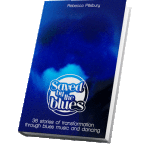Saved by the Blues – Book Launch and Blues Dance Party
 “You can dance to blues music?” is a common reaction when someone says, “I’m a blues dancer.” Many will conjure up images of solo or partnered swaying, reminiscent of the dancing at a high school prom. But contemporary blues dancing looks more like what one may have encountered in a juke joint in the first half of the twentieth century, but with a modern flair. Maybe you’ve even seen this new wave of blues dancers hit the floor at Portland’s Waterfront Blues Festival without knowing a whole international community dedicated to the dance exists.
“You can dance to blues music?” is a common reaction when someone says, “I’m a blues dancer.” Many will conjure up images of solo or partnered swaying, reminiscent of the dancing at a high school prom. But contemporary blues dancing looks more like what one may have encountered in a juke joint in the first half of the twentieth century, but with a modern flair. Maybe you’ve even seen this new wave of blues dancers hit the floor at Portland’s Waterfront Blues Festival without knowing a whole international community dedicated to the dance exists.
Blues dancing as we know it today evolved from the swing dance revival of the 1990s and early 2000s. All across the United States and Europe, multi-day swing dance events — Lindy exchanges — catered to the new aficionados of the black vernacular dances of the 1920s–1940s. The organizers began hosting late-night “blues rooms.” After the exhausting physical demands of a full day of Lindy Hop dancing, dancers would migrate over to the slower, smoother style of dance that blues music inspired.
Before long, people became interested in the intimate partner dance as a style of dance in its own right. Traditional slow dance steps — like those seen in juke joints — were either incorporated or modified to result in the dance that became known as “blues.” Leaders in various swing dance communities began hosting blues dance house parties, attracting local, regional, and even international dancers. Parties began taking place around the world and evolved into “blues exchanges,” which — like Lindy exchanges — serve the purpose of not only familiarizing communities with dance styles evolving in other parts of the world but offering a sort of cultural and social exchange.
The dance itself is difficult to define; just as the music itself is constantly evolving and being influenced by what is popular of the day, the dance movements are adapting to influences from different cultures, new adaptations of blues-rooted music, and each dancer’s own personality. Blues dances as a genre, however, tend to share an aesthetic that includes a grounded body posture where the weight is held on the balls of the feet, the knees are bent, the hips are back, and the chest is forward; improvisation on an individual level and between dance partners, and dancing in the space between the beats — creating a sense of tension in the body while remaining loose and relaxed.
A key trait that defines the dance is intimacy. Danced most often in close embrace, the dance is raw, vulnerable, and exposed. Like blues music itself, the intention is not to hide or avoid who you are and what you’re going through but to face yourself and your partner fully and by doing so transcend time, space, and fear. As a result, the dance can be powerfully transformative. Many people would even say that the dance, and the community, “saved” them.
In fact, Portland author Rebecca Pillsbury’s upcoming book, Saved by the Blues will feature the transformational stories of thirty-six dancers. Included in the book are inspirational interviews with Portland blues musicians Curtis Salgado, Kevin Selfe, and Dean Mueller — all these musicians have played for blues dancers, if not participated in the dance themselves. After playing for blues dancers for the first time, Salgado declared, “I’ll remember this night the rest of my life.”
The dance is important not only on an individual scale, however, but globally as well. As many contributors to the book brought to light, where else can you share an intimate three-minute experience across gender, racial, and cultural boundaries in a socially acceptable way, if not on the dance floor. Dancing is a rare opportunity to communicate and develop bonds without words and without biases.
Moreover, as Salgado, Selfe, and Mueller all agreed, blues dancing may be traditional blues music’s best hope at staying alive — the dance is exposing younger generations to the likes of Muddy Waters, Howlin’ Wolf, Ma Rainey, and other early blues legends.
A book launch dance party for Saved by the Blues will be held Monday, April 25 at 7 pm at The Lake Theater in downtown Lake Oswego. Guests will be in for a special treat as renowned blues musicians take the stage to read excerpts from their stories and of course — to play the blues. For more information on this special event, visit www.laketheatercafe.com. A sneak peek of Saved by the Blues can be read at www.savedbythebluesbook.com.

